Python | An article to understand Python list, tuple and string operations
Good article recommendation, transferred from CSDN, the original star StarDust
sequence
- A sequence is a collection with indexing and slicing capabilities.
- Lists, tuples, and strings have the ability to access a specific value through index, or return a slice through slice.
- Lists, tuples, and strings are all sequences
1 List#
List (List) is a very important built-in data type in Python. The list consists of a series of elements, all tuples are enclosed in square brackets. After the list is created, you can add, delete, and modify operations.
The list can contain any Python data information, such as strings, numbers, lists, tuples, etc.
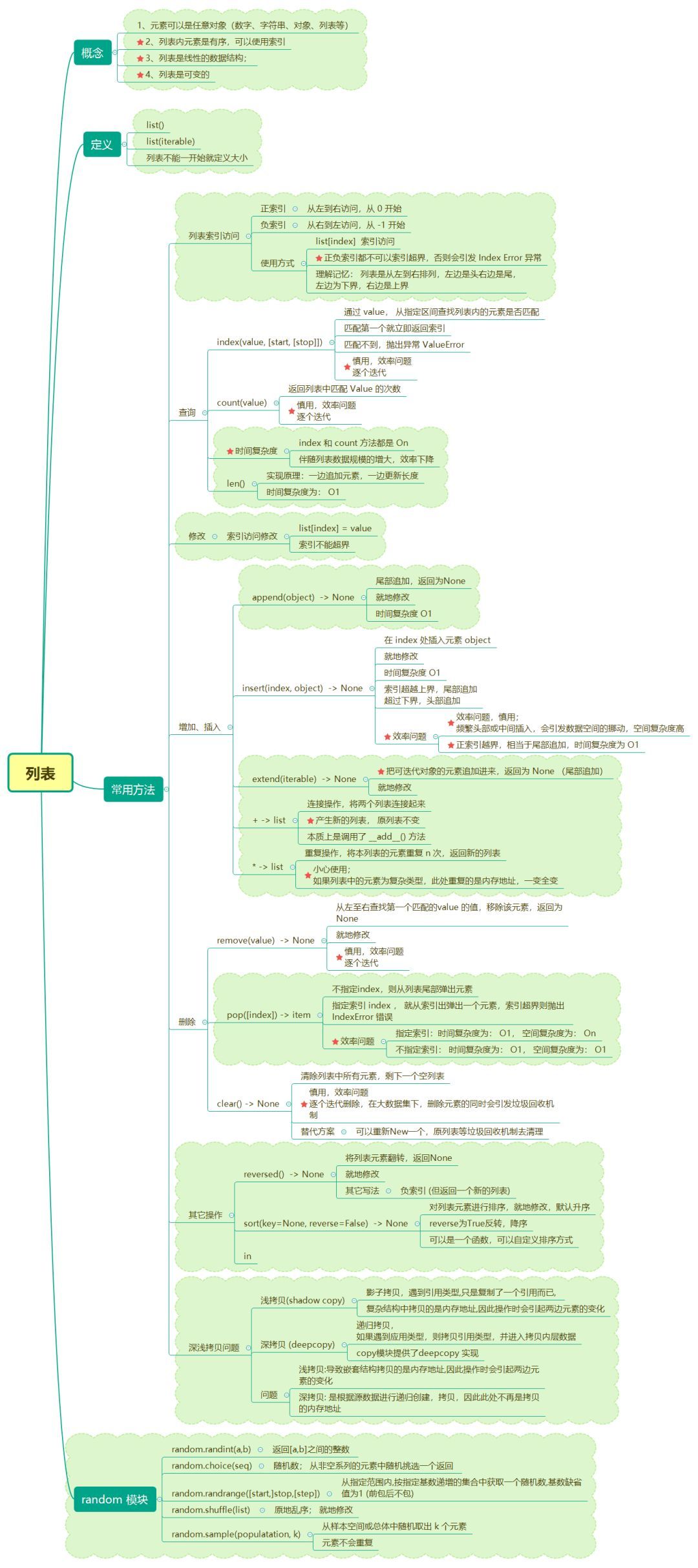
1.1 List introduction##
A list is an ordered collection with no fixed size and can store any number of Python objects of any type. The syntax is [element 1, element 2, ..., element n].
【example】
>>> list =[ “a”, “b”, “c” ]To define a list of characters.
>>> list =[1,2,3,4]To define a list of numbers.
>>> list =[[1,2,3,4],["a","b","c"]], The list of definition lists.
>>> list =[(1,2,3,4),("a","b","c")]To define a list of tuples.
>>> list((1,2))Convert a tuple into a list[1,2], list('test')Can put
String into['t','e','s','t']List
List notes:
- The number of elements in the list and the value of the elements can be changed;
- The elements in the list are wrapped in square brackets ([]);
- Different elements in the list are separated by commas (,);
- The list can contain any data type or another list;
- List members can be accessed by serial number;
- You can insert, delete, sort, and modify an element in the list.
1.2 List operation##
All operations of the list are shown in the following table:

1.2.1 List script operator###
The operators of the list pairs + and * are similar to strings. The + sign is used for combined lists, and the * sign is used for repeated lists.
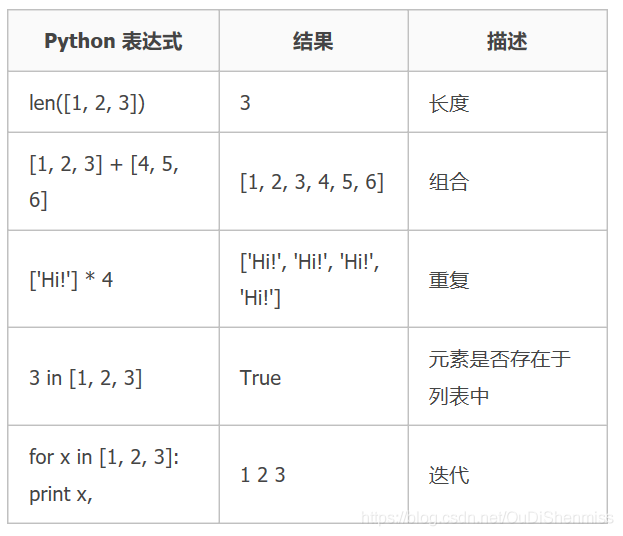
1.2.2 List slice###
The slice operation (slice) can obtain a sublist (part of a list) from a list. We use a pair of square brackets, start offset start, end offset end, and optional step size step to define a slice.
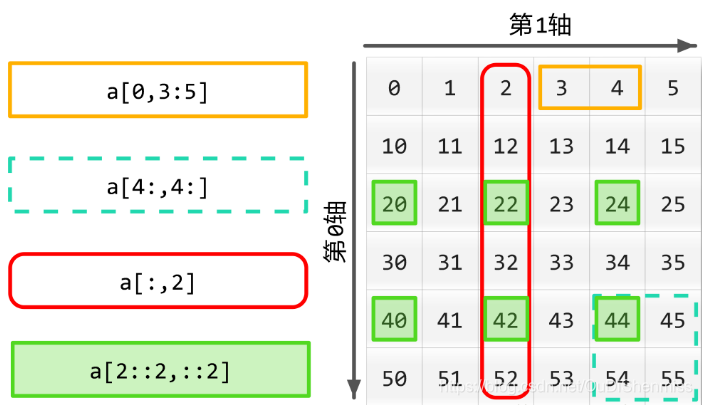
Format: [start: end: step]
• [:] Extract the entire string from the beginning (default position 0) to the end (default position -1)
• [start:] Extract from start to the end
• [:end] Extract from the beginning to end-1
• [start: end] Extract from start to end-1
• [start: end: step] Extract from start to end-1, extract one character per step
• The position/offset of the first character on the left is 0, and the position/offset of the last character on the right is -1
【example】
>>> list =[1,2,3,4,5,6,7]>>> list[1:] #List after index 1---------[2,3,4,5,6,7]>>> list[:-1] #List index-Before 1-------[1,2,3,4,5,6]>>> list[1:3] #List index1到3之间的-----[2]>>> list[::-1]#[7,6,5,4,3,2,1] #Form the effect of the reverse function:
1.2.3 Shallow copy and deep copy###
- Shallow copy: Shallow copy means constructing a new collection object and then filling it with references to child objects found in the original object. In essence, a shallow copy is only one layer deep. The copy process is not recursive, so no copy of the child object itself is created.
- Deep copy: Deep copy makes the copy process recursive. This means that a new collection object is constructed first, and then it is recursively filled with copies of child objects found in the original object. Copying an object in this way traverses the entire object tree to create a completely independent clone of the original object and all its children.
A. Assignment reference
a ={1:[1,2,3]}
b = a
print(id(a)==id(b))
Output:
True
Assignment reference, a and b both point to the same object.
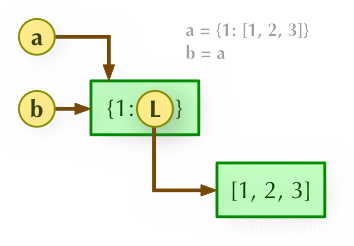
B. Shallow copy
a ={1:[1,2,3]}
b = a.copy()print(id(a)==id(b))print(id(a[1])==id(b[1]))
Output:
False
True
a and b are independent objects, but their child objects still point to a unified object (reference).
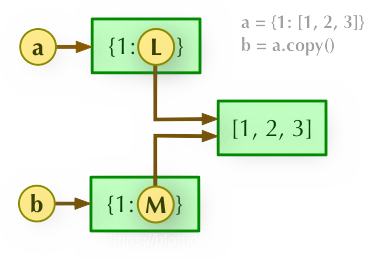
C. Deep copy
import copy
a ={1:[1,2,3]}
b = copy.deepcopy(a)print(id(a)==id(b))print(id(a[1])==id(b[1]))print(id(a[1][0])==id(b[1][0]))
Output:
False
False
True
a and b completely copy the parent object and its children, and the two are completely independent. For a[1][0] and b[1][0], it is still a reference to object 1, and no new object is created. This conforms to the python storage mechanism.
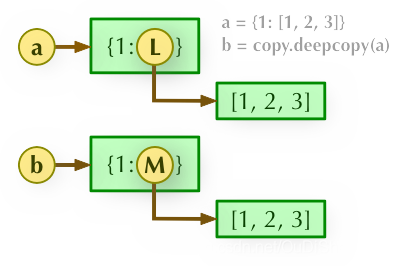
1.2.4 Other common operations###
-
-
-
-
-
- List sort:
Pay attention to the sorting priority: numbers>uppercase letters>lowercase letters>symbols>Chinese
The Python list built-in sort() method is used to sort, and you can also use the Python built-in global sorted() method to sort the iterable sequence to generate a new sequence.
- List sort:
-
-
-
-
-
Permanent sorting: sort()
list.sort(key=None, reverse=False)Sort the original list.
key-It is mainly used to compare the elements. There is only one parameter. The parameters of the specific function are taken from the iterable object and specify an element in the iterable object for sorting.reverse-sorting rule,reverse = Truedescending order,reverse = Falseascending order (default). This method has no return value, but it sorts the objects in the list. -
Temporary sorting: sorted()
Python built-in functions, -
Reverse sort: reverse()
【example】
>>> list1 =[3,5,1,6,9]>>> lsit2 =[3,5,1,6,9]>>> a = list1.sort() #Permanently sort, just this list will change
>>> print(a, l1)
# None [1,3,5,6,9]>>> b =sorted(list1) #Temporary sorting means that a variable can be assigned
>>> print(b, list1)
# [1,3,5,6,9][3,5,1,6,9]>>> c = list2.reverse()>>>print(c, list2)
# None [9,6,1,5,3]
-
-
-
-
-
- The difference between append and extend in the list:
-
-
-
-
-
list.append(object) Add an object object to the list
-
list.extend(sequence) adds the content of a sequence seq to the list
2 Tuple#
2.1 Tuple operations##
Python tuples are similar to lists. The difference is that tuples cannot be modified after they are created, similar to strings.
- Use parentheses for tuples and square brackets for lists.
- Tuples can be used when you do not want the data to be changed by other operations.
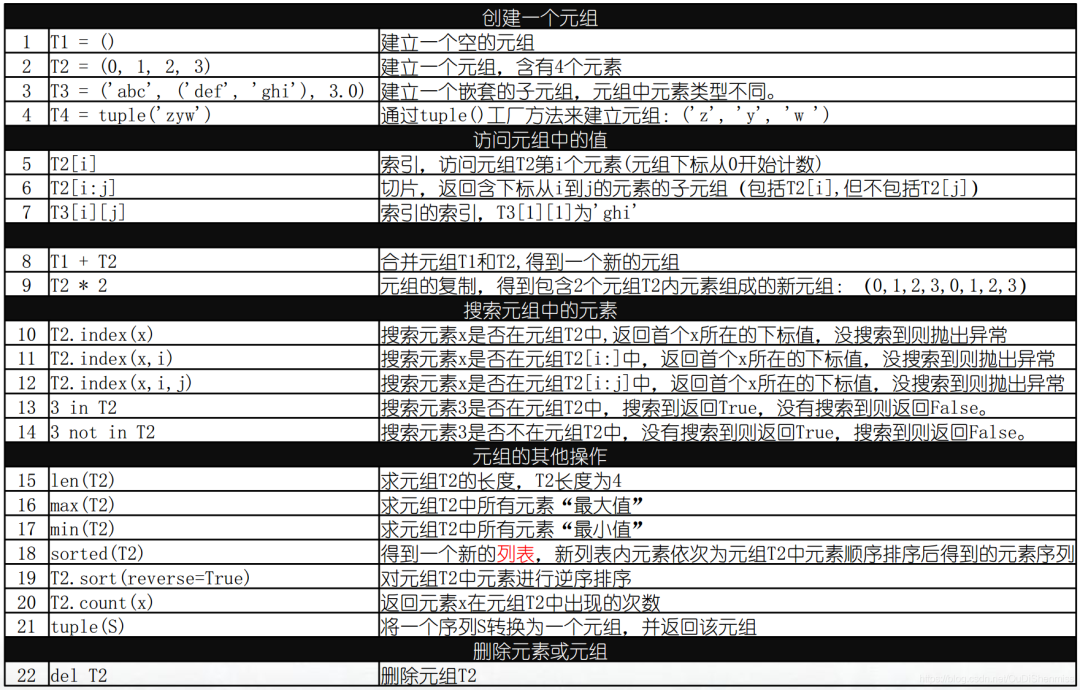
2.2 Unzip Tuple##
Unpack one-dimensional tuples (there are several elements left parenthesis define several variables)
【example】
( a, b, c)=(1,10.31,'python')print(a, b, c)
# 110.31 python
Decompress two-dimensional tuples (define variables according to the tuple structure in the tuple)
【example】
t =(1,10.31,('OK','python'))(a, b,(c, d))= t
print(a, b, c, d)
# 110.31 OK python
If you only want a few elements in the tuple, use the wildcard character "*", which is called wildcard in English, which represents one or more elements in computer language. The following example is to throw multiple elements to the rest variable.
【example】
t =1,2,3,4,5
a, b,*rest, c = t
print(a, b, c) # 125print(rest) # [3,4]
If you don't care about the rest variable at all, then use wildcard "*" and underscore "_".
【example】
a, b,*_ = t
print(a, b) # 12
3 String#
3.1 String introduction##
Definition of string:
A string is a collection of characters between quotation marks, where quotation marks include single quotation marks, double quotation marks, and triple quotation marks (three consecutive single quotation marks or double quotation marks).
【example】
>>> s1='I love Python'>>> s1
' I love Python'>>> s2=str([1,2,3])>>> s2
'[1, 2, 3]'
Python escape characters
Add u, r, b before the string
- u"A string of Chinese characters"
Function: Encode in Unicode format, which is generally used in front of Chinese strings to prevent garbled characters when used again due to source code storage format problems. - r"\n\n\n\n" # Represents an ordinary raw string\n\n\n\n, not a newline
Function: Remove the backslash escape mechanism, which is often used in regular expressions, corresponding to the re module. - b'Hello World' # indicates that this is a bytes object
Function: b" "prefix means: the following string is of type bytes. In network programming, servers and browsers only recognize bytes type data. In Python3, the conversion between bytes and str is str.encode('utf-8') and bytes.decode('utf-8').
3.2 String formatting##
Python supports the output of formatted strings. Although very complicated expressions may be used in this way, the most basic usage is to insert a value into a string with the string format character %s. In Python, string formatting uses the same syntax as the sprintf function in C.
【example】
print "My name is %s and weight is %d kg!"%('Zara',21)
# My name is Zara and weight is 21 kg!
Python string formatting symbols:
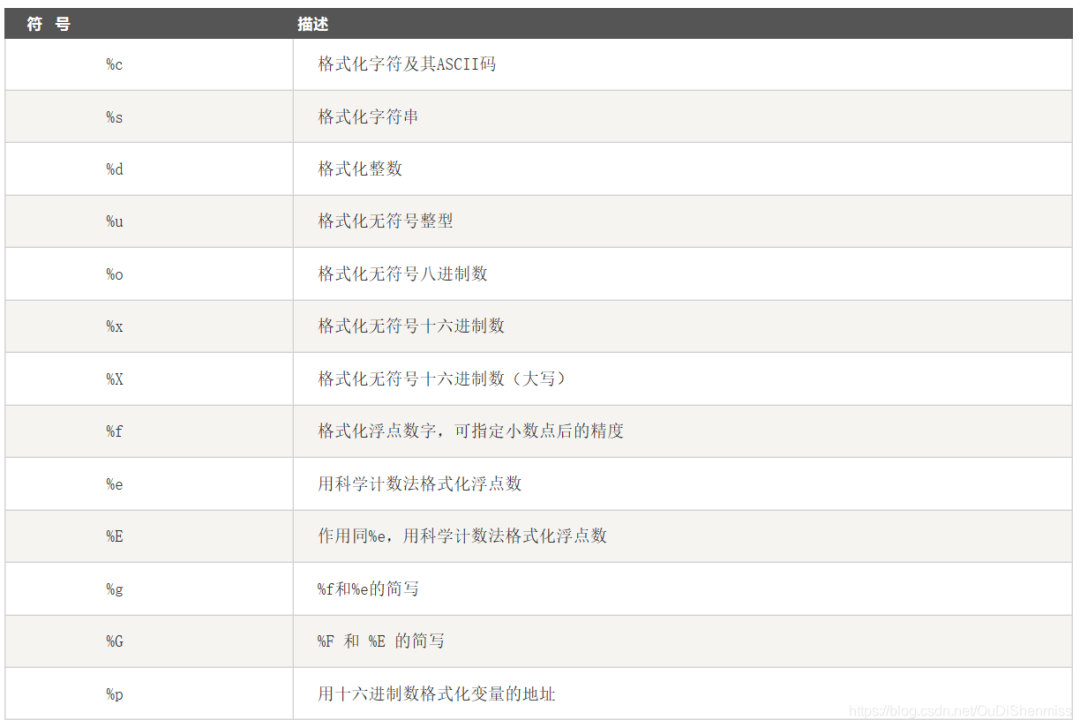
Formatting operator auxiliary instructions:
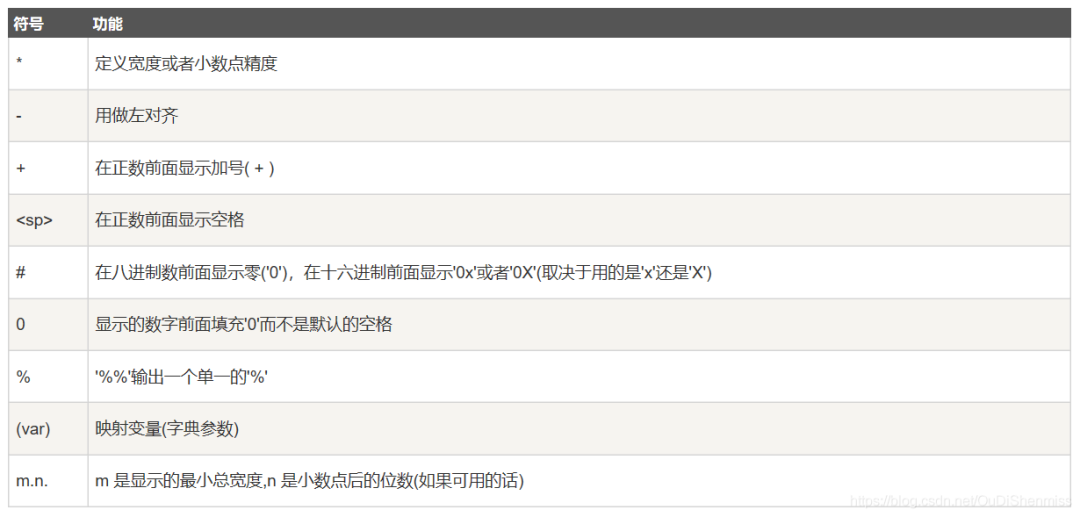
3.3 format Formatting function##
Starting from Python2.6, a new string formatting function str.format() has been added, which enhances the function of string formatting.
- The basic syntax is to use {} and: to replace the previous %.
- The format function can accept an unlimited number of parameters, and the positions can be out of order.
【example】
>>>"{} {}". format("hello","world") #Do not set the specified location, follow the default order
' hello world'>>>"{0} {1}".format("hello","world") #Set the specified location
' hello world'>>>"{1} {0} {1}".format("hello","world") #Set the specified location
' world hello world'
- You can also set parameters:
print("Site name:{name},address{url}".format(name="Novice Tutorial", url="www.runoob.com"))
# Set parameters via dictionary
site ={"name":"Novice Tutorial","url":"www.runoob.com"}print("Site name:{name},address{url}".format(**site))
# Set parameters by list index
my_list =['Novice Tutorial','www.runoob.com']print("Site name:{0[0]},address{0[1]}".format(my_list)) # "0"It's required
Number formatting
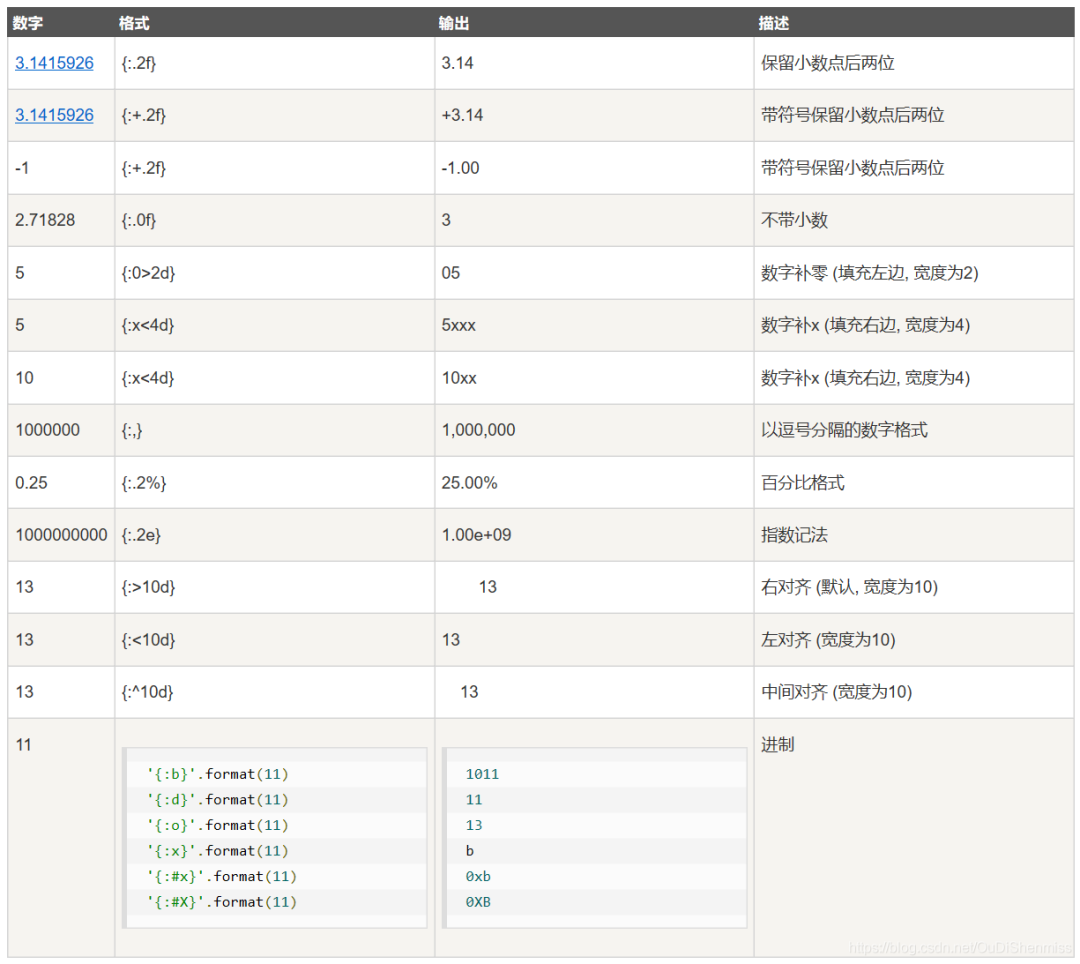
^, <, > They are centered, left-justified, right-justified, followed by a width, and the character with padding after the: sign can only be one character. If it is not specified, it will be filled with spaces by default.
- Shows + before positive numbers,-before negative numbers; (space) means add spaces before positive numbers
b, d, o, and x are binary, decimal, octal, and hexadecimal, respectively.
【example】
>>> print("{:.2f}".format(3.1415926));3.14>>>print("{}The corresponding position is{{0}}".format("runoob"))
The location of runoob is{0}
Practice questions:
1、List manipulation exercise
The contents of the list lst are as follows
lst = [2, 5, 6, 7, 8, 9, 2, 9, 9]
Please write a program to complete the following operations:
- Add element 15 to the end of the list
- Insert element 20 in the middle of the list
- Merge the list [2, 5, 6] into lst
- Remove the element with index 3 in the list
- Flip all elements in the list
- Sort the elements in the list, from small to large once, and from large to small once
>>> lst =[2,5,6,7,8,9,2,9,9]>>> lst.append(15)>>> lst.insert(5,20)>>> lst.extend([2,5,6])>>> del lst[3]>>> lst.reverse()>>> lst.sort()>>> lst.sort(reverse=True)
Original address
https://blog.csdn.net/OuDiShenmiss/article/details/107599379
Love&Share [Finish]
Recommended Posts